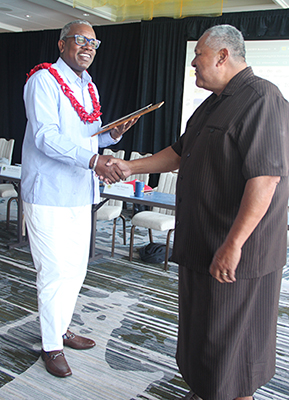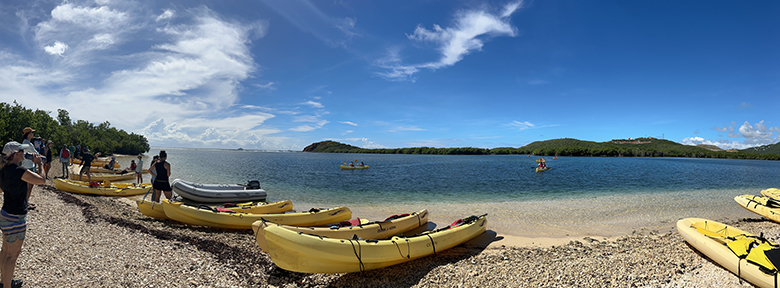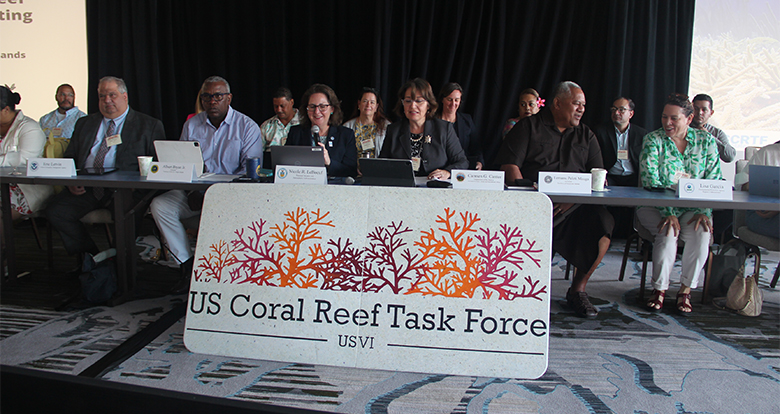CHARLOTTE AMALIE — The USVI hosted a successful U.S. Coral Reef Task Force Meeting that showcased local projects, partners, and resources while fostering national coordination on coral reef issues and initiatives.
The U.S. Virgin Islands (USVI) hosted the 47th U.S. Coral Reef Task Force Meeting in October, their first time hosting in 10 years. The USVI was scheduled to host twice previously, but had to postpone due to impacts from hurricanes and COVID-19. This year, the meeting was threatened yet again a month before its commencement by the possibility of a government shutdown, followed by the development of a tropical storm nearby just days before the meeting began. However, the planning team persevered, nature cooperated, and together they pulled off a highly successful meeting filled with productive discussions, ground-breaking policy announcements, and numerous educational, but fun, receptions and site visits showcasing local projects, partners, and natural resources.

Governor Albert Bryan shakes hands with American Samoa Governor Lemanu Peleti Mauga.
The Task Force working groups are where the real magic happens, and six out of the seven were able to meet in some capacity to move forward with exciting initiatives. For example, the Watershed Working Group promoted Salt River on St. Croix as a new priority watershed, and the Coral Disease Working Group facilitated a training for Pacific managers on coral disease preparedness and response. Check out the new resolutions related to both these working groups. In addition, for the first time ever all the working group leaders came together to help coordinate mutual efforts and facilitate information exchange.
One major highlight of the week was Governor Albert Bryan signing an executive order declaring many of the territory’s ecosystems, including coral reefs, mangroves, beaches, and seagrass beds, as natural infrastructure. Consequently, he also instructed local agencies to seek increased funding to protect and conserve them.

Kayaks pulled up on the shore of Cas Cay, an undeveloped and protected island off of St. Thomas.
Perhaps the most exciting part of the week was the awesome line up of site visits! Starting bright and early on Monday, we took a watershed tour, which highlighted some major land-based sources of pollution, such as the local landfill. After that, we kayaked in the St. Thomas East End Reserves to see some of the beautiful and protected mangrove systems. Our amazing guides at VI EcoTours taught us all about these complex ecosystems, which we depend on for coastal protection, carbon sequestration, and recreation. Additionally, they serve as habitat for a wide variety of native wildlife, including many commercially important fish species.
The week continued with excellent adventures such as touring the University of the Virgin Islands’ new lab facilities to learn about their amazing coral and mangrove restoration research; snorkeling at an offshore cay to witness coral bleaching and the impacts of disease firsthand; hiking ridge to reef through a nature preserve down to Magen’s Bay Beach; and, measuring mangrove outplants at Hull Bay while learning about the community-led restoration efforts going on there.

Coral fragments growing in one of University of the Virgin Islands’ lab tanks (left), UVI mangrove seedlings prior to outplanting (middle), and a snorkeler swimming by a partially bleached elkhorn coral (right).
Evening receptions showcased local culture, cuisine, entertainment, and communities. We experienced fresh-caught local wahoo while quadrille dancers twirled away inside the historic Fort Christian. We grooved with Moko Jumbies to the steelpan youth group Rising Stars while tasting local vegan cuisine from The Pressure Spot. And, we discussed connections between coral restoration and local culture at Coral World Ocean Park. Overall, the week was a blast and it was an honor to have the opportunity to share our USVI projects, resources, community, and local color with partners from across the nation, reminding them why the USVI is known as America’s Paradise. Being part of the U.S. Coral Reef Task Force is an important component of our coral conservation goals, and we look forward to the next meeting!
By LESLE MARIE HENDERSON, USVI CZ/Coral Management Liaison



